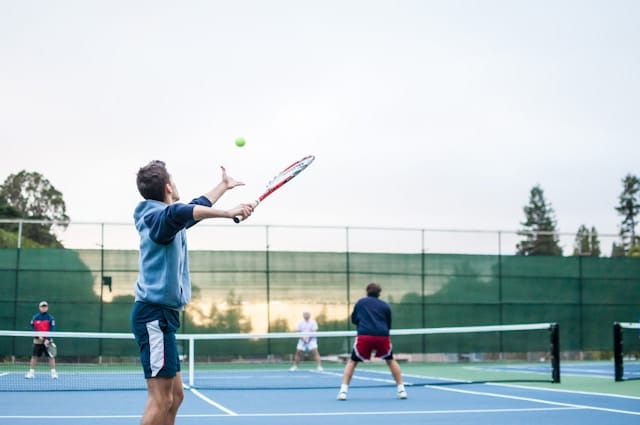How does the type of court surface impact injury prevention strategies in tennis?

In the dynamic world of sports, tennis holds a unique place, a blend of power, agility, and endurance. As you immerse yourself in this fascinating universe, understanding the different aspects that can impact the game is crucial. One of these aspects is the type of court surface on which the game is played. Tennis surfaces can be diverse, including grass, clay, and hard courts. Each surface has its own characteristics that influence the style of play, and more importantly, the risk of injuries to players.
Based on data collected from various sources like Google Scholar and PubMed, as well as an in-depth analysis, it is evident that the type of court surface can significantly affect injury prevention strategies. The following sections will delve deeper into how these surfaces impact the game and what measures can be taken to mitigate the risk of injuries.
A lire aussi : What are the latest innovations in sports wheelchairs to enhance mobility for Paralympic racers?
Injury Risk on Different Court Surfaces
Each type of court surface presents a unique challenge to the players. Grass courts are fast and require quick reflexes, while clay courts are slow and demand high endurance. Hard courts, on the other hand, are known for their consistent bounce and speed. These differences not only dictate the pace and style of play but also influence the risk and type of potential injuries.
Grass courts typically result in more slips and falls, leading to acute injuries such as sprains and strains. Clay courts, being softer and slower, reduce the risk of acute injuries but have a higher incidence of chronic, overuse injuries due to the longer rallies. Hard courts pose the greatest risk for lower limb injuries because of the high-impact nature of the game on these surfaces.
A découvrir également : What are the best practices for sleep hygiene to maximize recovery for elite athletes?
A study published in the British Journal of Sports Medicine used injury surveillance data from professional tennis tournaments to compare the injury risk on different court surfaces. The study found that the injury risk was highest on hard courts, followed by clay and grass courts.
Preventive Strategies for Each Court Surface
Understanding the type of injuries common on each court surface is the first step towards injury prevention. The next step is implementing preventive measures that are specific to each surface.
On grass courts, where slipping and sliding are common, wearing shoes with good grip can help prevent falls. Regular court maintenance to ensure the grass is not too slick is another preventive measure.
In contrast, clay court players should focus on building their endurance and strength, particularly in the lower limbs, to prevent overuse injuries. Proper warm-up and cool-down routines, along with regular rest periods, can also go a long way in preventing injuries on this surface.
For hard courts, players should invest in footwear that provides good shock absorption to reduce the impact on their joints. Moreover, incorporating strength and flexibility training for the lower limbs, as well as core stability exercises, can help mitigate the risk of injuries.
Role of Medical Teams in Injury Prevention
Medical teams play a vital role in injury prevention in tennis. They not only treat injuries when they occur, but also work on preventive strategies based on the type of court surface players are competing on.
Before a tournament, medical teams assess the players’ physical condition and provide them with individualized exercise programs aimed at reducing the risk of injuries associated with the specific court surface. For example, before a clay court tournament, players might be given exercises to strengthen their lower limb muscles and improve their endurance.
During a tournament, the med team is on standby to provide immediate care in case of acute injuries. They also monitor the players’ health and adjust their exercise programs as needed.
The Impact of Technology on Injury Prevention
The advancements in technology have made it possible to gather and analyze data on a scale never before possible. With the help of technology, researchers and medical teams can track players’ movements, assess their physical condition, and predict injury risks more accurately.
For instance, data from wearable devices can provide insights into a player’s physical condition and performance. Analysis of this data can help in identifying weaknesses or imbalances that might increase the risk of injuries.
Moreover, by studying the players’ movements on different court surfaces, researchers can understand the biomechanics of the game better. This knowledge can be used to design training programs and preventive measures that are tailored to each court surface.
In conclusion, the type of court surface can significantly impact the risk of injuries in tennis. However, with the right preventive strategies, medical support, and use of technology, it is possible to mitigate this risk and ensure the players’ safety.
Tennis Injuries and Their Long-Term Effects on Players
Diving deeper into the study of injuries on different types of court surfaces, it is important to understand the long-term effects these injuries can have on tennis players. Drawing references from notable sources like PubMed and Google Scholar, sports medicine professionals are able to comprehend the impact of these injuries more accurately.
According to the British Journal of Sports Medicine, grass courts often result in acute injuries such as sprains and strains due to the higher chances of slips and falls. Although these injuries can heal with time, repeated occurrences can lead to long-term issues like instability and weakness in the affected joints. Therefore, players frequenting these courts need to ensure adequate rest and proper medical rehabilitation after an injury.
On clay courts, due to longer rallies, players are more prone to chronic, overuse injuries, notably ‘tennis elbow’. This condition, if not addressed properly, can lead to persistent pain and reduced performance in the long run. Hence, clay court players need to adopt strategies like strength training and regular rest periods to prevent these injuries from becoming permanent issues.
Hard courts are believed to have the highest injury rates, particularly when it comes to lower limb injuries. Long-term exposure to high-impact sports like tennis on hard courts can lead to degenerative conditions like arthritis in the knees and ankles. Therefore, preventive measures such as wearing shock-absorbing footwear and incorporating strength and flexibility training become essential for hard court players.
Evolving Strategies for Injury Prevention
With the dynamic nature of tennis and the increasing speed of the game, injury prevention strategies are constantly evolving. Advanced research through Google Scholar and PubMed, as well as real-time data analysis, are significantly contributing towards improved preventive measures.
One of the most critical aspects of injury prevention is education. Top players are increasingly being educated about the risks associated with different court surfaces. They are taught about the importance of strength training, warm-ups and cool-down routines, and the appropriate use of sports equipment like footwear.
Another significant aspect is the role of medical teams. They provide tailor-made exercise programs for each player, considering their physical condition and the type of court they usually play on. This individualized approach helps in preventing injuries and ensures that the players stay in top shape.
Furthermore, the use of technology in sports med is transforming the approach towards injury prevention. Wearable devices are being used to track players movements and assess their physical conditions. Analysis of this data gives insights into potential injury risks and helps design preventive measures that are specific to each player’s needs.
Conclusion
In conclusion, the type of court surface has a profound impact on potential injuries in tennis. However, by comprehending this data collected from various sources like Google Scholar and PubMed, sports medicine professionals are making significant strides in injury prevention strategies. A combination of education, individualized exercise programs, medical support, and the use of technology are proving to be effective in reducing injury rates.
Whether it’s acute injuries on grass courts, chronic issues on clay courts, or lower limb injuries on hard courts, each player needs to adopt preventive measures that are specific to their situation. In doing so, they not only extend their career in the game but also ensure a healthier life post-retirement. The goal is not just to create elite players who perform excellently but also to ensure these players can continue to enjoy the game they love without long-term repercussions on their health.
